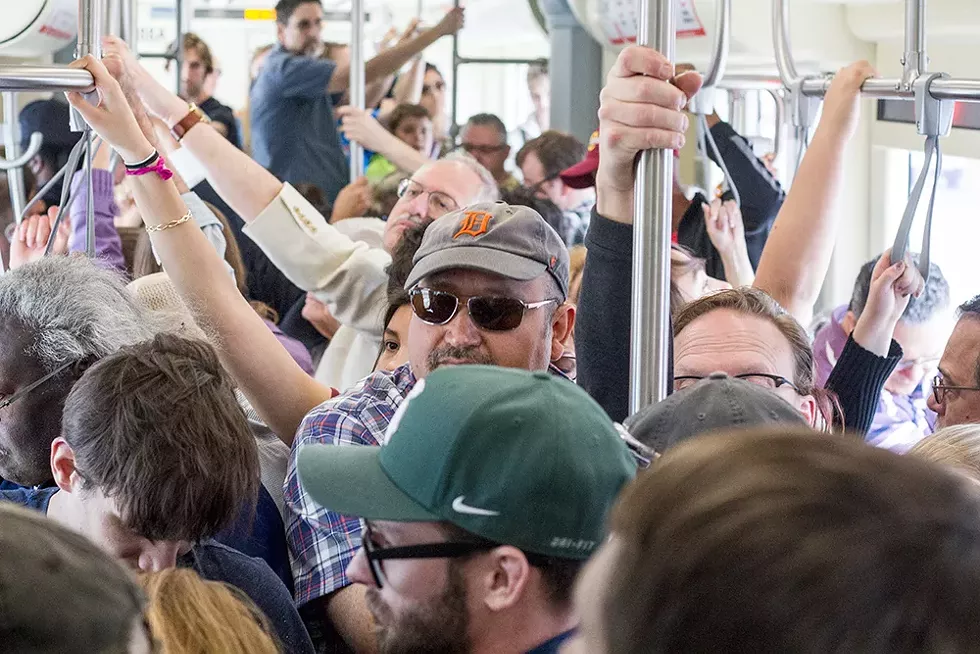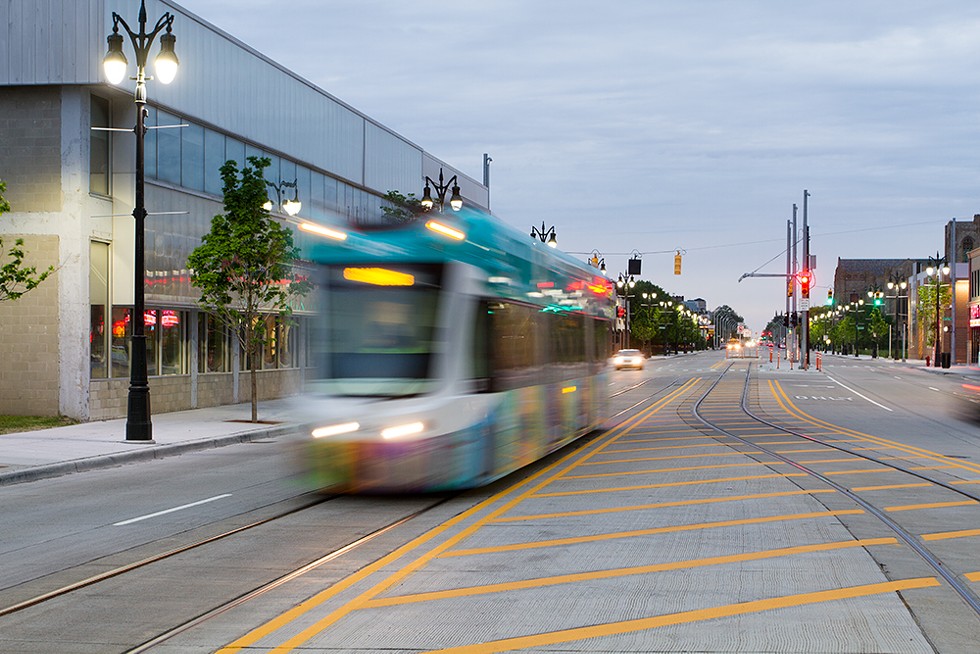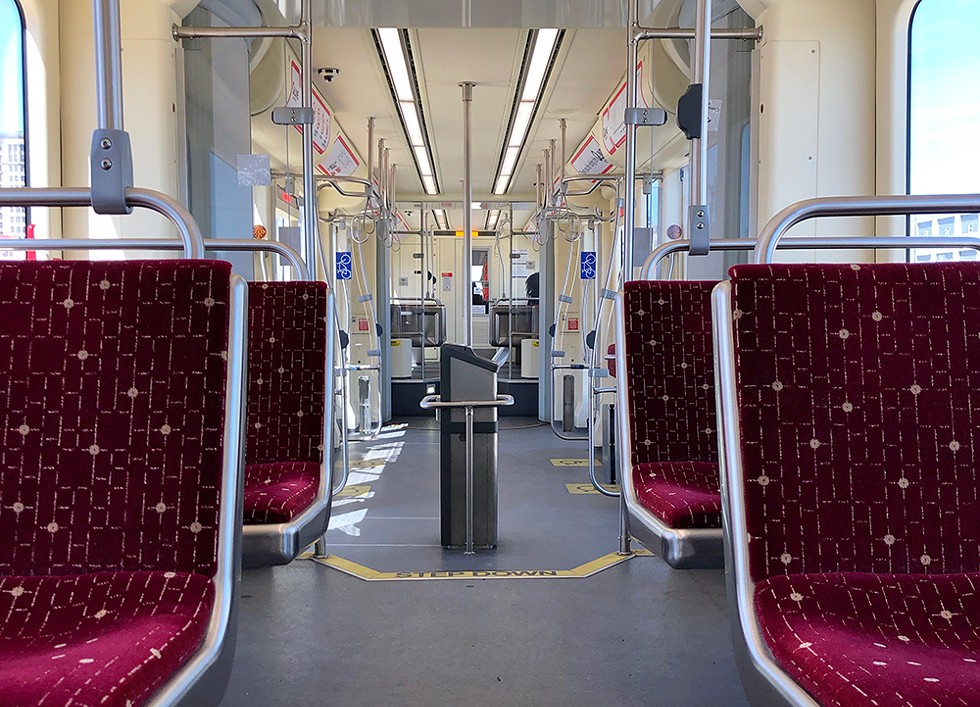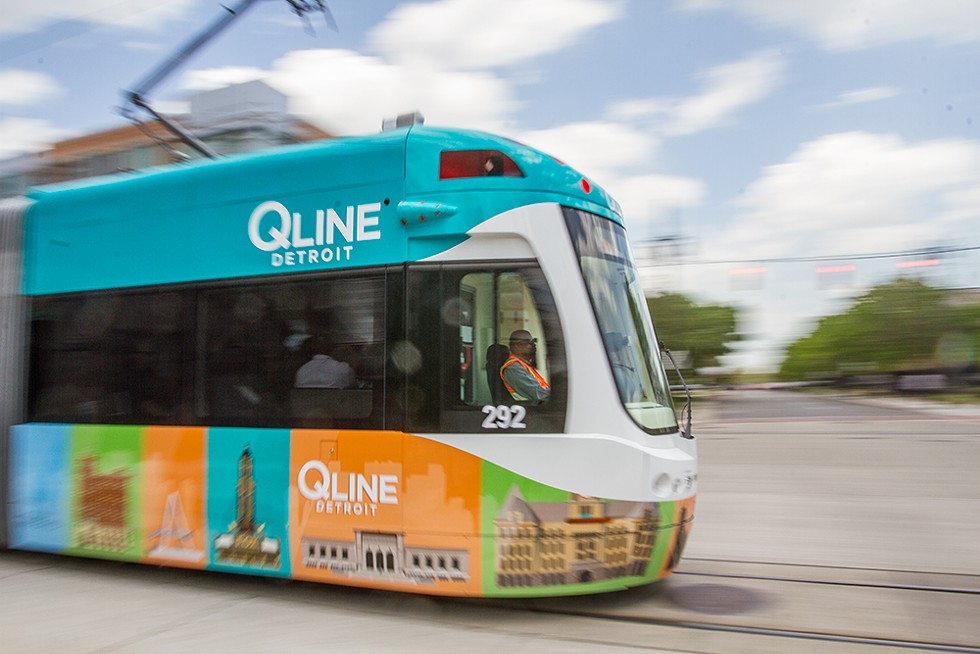When the $187 million QLine streetcars debuted in Detroit two years ago this month, city and business leaders boasted that the 3.3-mile system would be a quick, reliable form of transportation downtown and the first step toward a robust, regional transit system.
So far it's turned out to be neither.
The sleek, shiny streetcars have been beset by delays, infrequent stops, low ridership, mechanical failures, accidents, and a ballooning budget.
Metro Times examined streetcars in 12 other cities, scoured federal transportation records, interviewed riders and employees, timed the streetcar's stops, and even rode the QLine for eight straight hours.
Here's what we found:
• Ridership has reached record lows, falling far short of expectations.
• The cost to operate the streetcar has ballooned, and the QLine is recovering less than 10 percent of its expenses from fares.
• The streetcars are often delayed, blocked by illegally parked cars, emergency vehicles, car crashes, snarled traffic, delivery trucks, and roadwork.
• QLine leaders made a number of exaggerated claims and have not yet succeeded in connecting the streetcars with buses or other regional transit as promised.
• The QLine is much slower than advertised, averaging 8.3 mph.
• One of the main reasons voters and suburban leaders are rejecting a new regional transit system is because they don't want to subsidize the QLine as part of it.
• Streetcar operators told us they're frequently overworked, exhausted, and denied lunch breaks.
• The streetcars were involved in 46 accidents from 2017 to 2018.
Despite the serious shortcomings, there are signs of improvement, and the private, nonprofit group that operates the streetcars, M-1 Rail, remains optimistic about the QLine's future.
"Our top priority is ensuring the QLine is safe and reliable for our riders," says M-1 Rail spokesman Dan Lijana. "Like every new transit system, we learned much from our first year of operations."
Declining ridership
Ridership has fallen well short of expectations and is in decline.
In the first two months of 2019, the QLine's ridership plummeted to its lowest point since the streetcars debuted on May 12, 2017, according to records obtained by the Federal Transit Administration.
In that same timeframe the streetcars ferried an average of 2,490 riders a day, far lower than the projected 5,000 to 8,000 daily riders. In fact, ridership only matched expectations in the QLine's inaugural four months.
In 2018, the first full year of operations, the QLine ferried an average of 3,376 riders a day, down from an average 4,405 daily rides in 2017.
A major factor in the decline appears to be the introduction of a fare in September 2017. For the inaugural four months, the QLine provided free rides. During that time, the streetcars averaged 5,438 daily riders. Since then, ridership has plunged 45 percent to 2,998 riders a day from September 2017 to February 2019.
On a recent weekday, the streetcars were nearly empty, often ferrying between just one and five riders. One of them was Leslie Scott, who bought into the QLine's initial hype. A waitress downtown, she figured she could hop on a streetcar for the brief 2-mile ride to work.
Then came the delays and unreliable wait times.
"I won't ride it if I have someplace to be," Scott says while sitting on a nearly empty streetcar. "I learned my lesson. It has made me late too many times."
M-1 Rail bought six 66-foot trains, which were designed to accommodate 125 people, at a cost of $5 million each. For that price, Detroit could have purchased 68 new buses.
The fares range from $1.50 for three hours to $3 a day. Fewer than 250 people have purchased annual passes, a sign that people aren't committed to relying on the QLine in the long term.
In the initial months after imposing fares, M-1 Rail leaders estimated 60 percent of the riders weren't paying. To improve compliance, the QLine beefed up enforcement.
In 2018, transit police issued tickets to 242 people for failing to pay. The citations are misdemeanors carrying penalties of up to 90 days in jail and up to a $500 fine.
But even riders who want to pay often have trouble doing so. One of the streetcars has operated for months without a working fare box. At Congress Street, the primary downtown station, the credit card machine doesn't work.
"Don't worry about it," we overheard a QLine operator telling a passenger who couldn't get the credit card machine to work at a station. "It happens all the time." It's unclear what percentage of riders are now paying fares, because officials don't keep track.
"There isn't a reliable percentage to measure because people can take multiple trips on one fare," Lijana says.
M-1 Rail officials estimate they will collect $600,000 fares in the annual operating budget that began on Oct. 1. That's less than 10 percent of the annual $6.7 million spending plan, compared to the projected 40 percent when the QLine was introduced.
M-1 Rail leaders originally estimated the QLine would cost $5 million to operate. The operating budget grew this year to $6.7 million, up from $5.8 million. Lijana said the budget has increased because of enforcement and longer hours of operation.
The growing budget could become a big problem because the QLine operates with a limited amount of private and government funds. M-1 Rail officials said last year they had about $40 million in pledged donations to operate the line through 2027. At this rate, the QLine doesn't have enough money to operate beyond 2023, Crains Detroit Business reported last year.
M-1 Rail CEO Matt Cullen said last year that the group may have to look for additional donations.
Detroit is not alone
Detroit's struggle to retain ridership is not unique. The so-called streetcar renaissance that began less than a decade ago has largely fallen short of overhyped expectations, and the federal government has stopped funding them.
Metro Times examined streetcars in 12 other cities and found that most are hemorrhaging ridership, costing more to operate, and are prone to long delays.
In Tampa, transit officials addressed declining ridership by ditching $1 fares in October for free ones. Since then, ridership has nearly tripled. A $2.7 million state grant allowed the city to make rides free.
About half of the nation's modern streetcars are free to ride.
Still, Detroit is attracting more riders than most cities with streetcars. In Dallas, Atlanta, and El Paso, average daily ridership is below 1,000. Cincinnati, Oklahoma City, and Charlotte attract fewer than 2,000 riders a day on average. Cities with ridership between 2,000 and 3,000 are Milwaukee, Tucson, Tampa, and Washington, D.C. Only Seattle and Kansas City average between 5,000 and 6,000 daily riders.
Transit experts said streetcar supporters nationwide have overestimated the popularity and reliability of streetcars, failing to foresee the shortcomings of a century-old form of transportation.
"Despite the proliferation of streetcar projects, there is remarkably little work on the streetcar's role as a transportation service," wrote authors of a study by the Mineta Transportation Institute. "There does seem to be a real disconnect between enthusiasm for the streetcar and its transportation performance."
Regional transit suffers
The original plan was to turn the streetcars over to the Regional Transit Authority of Southeast Michigan, which was created as an agreement with the U.S. Department of Transportation. But six months before the QLine launched operations, voters rejected a tax increase to fund the RTA, in part because suburban residents did not want to finance a streetcar that served a small population miles away in downtown Detroit.
In July 2018, the RTA's Board of Directors, which includes members from Oakland, Macomb, Washtenaw, and Wayne counties, prevented the tax increase from appearing on the 2018 ballot. They again cited the costs of the QLine as a factor in their decision.
In other words, the streetcars are becoming an impediment to the creation of a well-funded, regional transit system.
And that's the fault of billionaire benefactors such as Dan Gilbert and Roger Penske, who overhyped the streetcars to get public money that could have funded reliable transportation in a city where a quarter of the residents don't have a car, according to a 2018 study published in the Journal of Planning Education and Research.
"The streetcar plays a role in the uncertain future of the RTA," Kate Lowe and Joe Grengs wrote in what could be described as a cautionary tale of placing federal transit money in the hands of private interests. "Because the streetcar had such a limited reach and serves only the downtown core, some suburban leaders resist supporting the RTA because the RTA is scheduled to take over the operating expenses of the streetcar after ten years."
Researchers have argued that streetcars are more about lining the pockets of business owners than providing reliable transportation. "In most cities, streetcars are not being pursued primarily for the transportation benefits they might provide, but instead are being sought for the benefits they might provide with respect to development," a 2018 study by San Jose State University found.
‘There does seem to be a real disconnect between enthusiasm for the streetcar and its transportation performance.’
tweet this
In fact, M-1 Rail committee members who were interviewed for the Journal of Planning Education and Research report said they didn't believe buses would be a catalyst for "economic development." One committee member, cited anonymously, conceded that buses would have been more effective for Detroiters, but "Rich, white people don't ride buses."
The report examined how private benefactors ceded transit decisions from local governments for their own financial gain. In 2011, federal transportation officials dropped the idea of a streetcar in favor of bus rapid transit lines, which would have sent 70 speedy buses up and down Woodward, Gratiot, and Michigan avenues. Their reasons were obvious: Detroit's transit system was broken. Only 3 percent of residents have easy access to a bus that runs every 15 minutes or less, according to a study by the Center for Neighborhoods Technology.
The streetcars "were a silly idea," then-Mayor Dave Bing told me in 2011 when I was a reporter for the Detroit Free Press. "We need reliable transit that reaches the neighborhoods, where people most need it."
While Bing and then-Gov. Rick Snyder backed bus rapid transit, the M-1 Rail investor group intervened and lobbied hard for the streetcars. To make their case, investors with M-1 Rail produced a hefty report that grossly exaggerated the speed, reliability, and ridership of the streetcars.
Despite protests from Detroiters who wanted the express buses, the federal government opted to support the streetcars. The U.S. Department of Transportation dished out $37.2 million, and another $41 million in public money came from the state of Michigan, Wayne County, Wayne State University, and the Detroit Downtown Development Authority. In total, 42 percent of the QLine's startup costs, including building the rails and buying the streetcars, came from public and quasi-public money.
M-1 Rail officials pledged to integrate the streetcars with the region's two bus networks, DDOT and SMART, but it hasn't happened. Beginning this month, bus riders can seamlessly transfer between the two bus systems with a single pass. For reasons that remain unclear, the QLine is not accepting the universal passes.
"The streetcar does not improve accessibility for transit-dependent populations, who are largely black Detroit residents with needs for connections to regional jobs and opportunities," the authors of the Journal of Planning Education and Research study wrote.

Ignoring the public
Two of the biggest complaints about the QLine are its slow speed and its unreliable wait times.
Some of the frustration could have been avoided if M-1 Rail boosters took the advice of the public and the U.S. Department of Transportation, which recommended exclusive center-running lanes that wouldn't have to compete with other traffic. Regional transportation leaders also advocated for center lanes because they would better serve a future regional transit system. Bicyclists also wanted center lanes because rails are dangerous for bikes.
"State-of-practice investigation indicates that bicyclists in areas with streetcar tracks in the rightmost lanes are more likely to fall and be injured," federal transportation officials wrote to QLine officials. "If possible, the use of bicycles in lanes with streetcar tracks should be discouraged."
Just two months after the QLine debuted, a Wayne State University student was riding her bike when one of her tires got stuck on the tracks. She fell over the handlebars, landing on her face, which required reconstructive surgery.
Despite overwhelming support for center lanes, Gilbert and other boosters wanted curbside lanes, which forced the streetcars to share the road with buses, cars, and bicyclists.
M-1 Rail leaders argued that curbside lanes "would be better for supporting foot traffic and thus property values and local businesses," the Journal of Planning Education and Research study found.
"M-1 Rail leaders held considerable influence over decisions affecting the public" and "they understood the project as economic development, not transit improvement."
With curbside lanes, it's not uncommon for streetars to be held up by roadwork, car crashes, delivery trucks, parked cars, and emergency vehicles. One obstruction can halt the entire system, causing significant delays.
Between 2017 and 2018, the QLine was involved in 46 accidents, some of which forced services to halt for hours, though the QLine points out that most did not cause significant delays.
"It's important to note that our operators have not been cited in the traffic incidents and the vast majority of incidents are minor fender benders with limited service interruption, if any occurring," Lijana says.
On April 3, during lunchtime, the QLine was halted for several hours after a man was shot in the face in the middle of Woodward. Also that day, the streetcars were delayed twice by cars blocking the lane.
On Twitter, streetcar users often express their frustration with delays.
"What's new?" Gary Boguslawski tweeted. "People can walk quicker."
On March 5, Kyle Trottier was among a handful of people complaining on Twitter about stoppages.
"Unacceptable @qlinedetroit," he tweeted. "You are NOT a reliable service. Always breaking down, never on time. I am stopping my monthly pass. Not worth it!!!!"
During the winter, the QLine was often out of service for mechanical problems, such as the batteries not staying charged, stranding riders in the cold.
Between Jan. 20 and Jan. 31, when temperatures plummeted to single digits, the QLine announced 11 delays. On Jan. 31, the QLine halted service for more than three hours in the morning.
"Plz get it together," Freddy Rutine responded on Twitter. "It's freezing out."
Now M-1 Rail officials are conceding dedicated lanes would have been a better idea.
"Dedicated lanes for transit on portions of the route would greatly benefit the QLine and the bus system," Lijana says. "It would reduce our time in traffic, especially during events and improve the speed of operations significantly."
Nationwide, streetcars travel an average of 6.8 mph, which is roughly the pace of a brisk jog. In the past four years, runners in Detroit, Charlotte, Salt Lake City, and Washington, D.C., have outpaced streetcars to highlight their sluggish speed. In 2013, a reporter walked faster than a Portland streetcar.
‘M-1 Rail leaders held considerable influence over decisions affecting the public’ and ‘they understood the project as economic development, not transit improvement.’
tweet this
A Florida State University study of seven streetcar systems found that all of them "operate at speeds slower than the average motor bus in the local transit system, with most streetcar speeds less than half the average bus speed."
Before the QLine debuted, boosters claimed the streetcars would travel the length of the track in 15 to 18 minutes. Barring obstructions, the QLine averages 23 to 25 minutes to travel the length of the track, which translates to 8 mph. By comparison, cars cover the same route in an average of 7 minutes and 24 seconds, according to a U.S. Department of Transportation study.
The most common complaint is "the lack of accuracy of streetcar arrival times," which are primarily caused by lanes being blocked, Lijana says.
Federal transportation records show the QLine has succeeded in making the system faster. In 2017, the streetcars made an average 61 round-trips a day, compared to 81 in 2018. On weekdays, with five streetcars running in 2018, that's more than one hour for each streetcar to make a round trip.
Still, it seems M-1 Rail's insistence that arrival times are down to 10 minutes is an exaggeration. Metro Times timed the QLine for 43 hours during the weekday in recent months and found that arrival times average 14 minutes.
During our 16 trips on the QLine on a recent weekday, the streetcar took an average of 27 minutes to travel the length of the track. On one trip, the streetcar stopped at the Amsterdam station for more than 15 minutes. Only one other person was on board. The familiar voice of longtime TV anchorwoman Carmen Harlan came across the speaker: "We are delayed due to an incident." When asked why the streetcar was delayed, a streetcar employee responded flippantly, "Who knows. It's the QLine."
QLine operators complain
Metro Times recently met with three QLine operators, who said they are exhausted because they don't get lunch breaks on shifts that range from 8 to 10 hours.
The operators only get breaks when each streetcar reaches the end of the line in New Center. When the next streetcar arrives, they hop back on.
It's a tiresome cycle, they said.
The employees said they were recently barred from eating and drinking on the QLine after an operator dropped coffee on the control board.
With long delays, the operators can be stuck on streetcars for hours.
"I'm starving and exhausted by the time my shift ends," one of the operators says, speaking on condition of anonymity for fear of reprisal. "We can't keep this up. I'm afraid of falling asleep."
Despite the shortcomings, some riders are still happy. The streetcar was overflowing on a recent Friday evening, with lots of people downtown for the Detroit Tigers game, the Detroit Music Awards at the Fillmore, comedian Trevor Noah at the Fox Theatre, and pop star P!nk at Little Caesars Arena.
"It's not perfect, but it's a fun way to take the family to a Red Wings game," says Dan Webb, who took more than a dozen spins on the QLine without significant delays. "The kids love it. I just wish (the streetcars) were faster."
Lijana say the QLine will continue to improve with time. "Our top priority is ensuring the QLine is safe and reliable for our riders," Lijana says. "Like every new transit system, we learned much from our first year of operations. We've instituted transit signal prioritization at intersections on Woodward to make trips on the QLine faster. We've convened working groups to address specific event traffic and remove lengthy delays during high-traffic times and we've increased service to meet the demands of a thriving Woodward Corridor."
Lijana said M-1 Rail officials are still hopeful that the QLine can be turned over to a regional transit authority. "From its inception, M-1 Rail envisioned the streetcar project as a critical step toward the creation of a true regional transit system," Lijana says. "Members of the M-1 Rail board were essential in the creation of the RTA and we continue to support the development of a thriving regional transit system that includes the QLine, bus systems, and other modes of transit."
Average Streetcar Ridership:
El Paso: 500Dallas: 600
Atlanta: 900
Oklahoma City: 1,200
Cincinnati: 1,300
Charlotte: 1,900
Milwaukee: 2,400
Tucson: 2,500
Tampa: 3,000
Washington, D.C.: 3,300
Detroit: 3,376
Seattle: 5,000
Kansas City: 5,794
QLine Numbers:
2017 daily ridership: 4,4052018 daily ridership: 3,376
2019 daily ridership: 2,431*
Total riders: 2.3 million
Accidents: 46Average speed: 8.3 mph
Operating budget: $5 million (projected), $6.7 million (actual)
Revenue from fares: Estimated $600,000
* January and February are the latest numbers available
Stay on top of Detroit news and views. Sign up for our weekly issue newsletter delivered each Wednesday.




